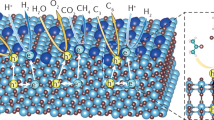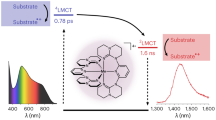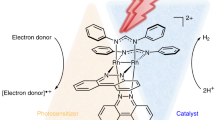Abstract
Light absorption across the bandgap in semiconductors is exploited in many important applications such as photovoltaics, light emitting diodes and photocatalytic conversion. Metals differ from semiconductors in that there is no energy gap separating occupied and unoccupied levels; however, it is still possible to excite electrons between bands. This is evidenced by materials with metallic properties that are also strongly coloured. An important question is whether such coloured metals could be used in light harvesting or similar applications. The high conductivity of a metal would preclude sufficient electric field being available to separate photocarriers; however, the high carrier mobility in a metal might also facilitate kinetic charge separation. Here we clearly demonstrate for the first time the use of a red metallic oxide, Sr1−xNbO3 as an effective photocatalyst. The material has been used under visible light to photocatalyse the oxidation of methylene blue and both the oxidation and reduction of water assisted by appropriate sacrificial elements.
This is a preview of subscription content, access via your institution
Access options
Subscribe to this journal
Receive 12 print issues and online access
$259.00 per year
only $21.58 per issue
Buy this article
- Purchase on Springer Link
- Instant access to full article PDF
Prices may be subject to local taxes which are calculated during checkout




Similar content being viewed by others
References
Shein, I. R., Kozhevnikov, V. L. & Ivanovskii, A. First-principles calculations of the elastic and electronic properties of the cubic perovskites SrMO3 (M=Ti, V, Zr and Nb) in comparison with SrSnO3 . Solid State Sci. 10, 217–225 (2008).
Peng, N. H., Irvine, J. T. S. & Fitzgerald, A. G. Synthesis and crystal structure of the distorted perovskite Sr0.97NbO3 determined by high resolution powder neutron diffraction. J. Mater. Chem. 8, 1033–1038 (1998).
Ridgley, D. & Ward, R. The preparation of a strontium–niobium bronze with the perovskite structure. J. Am. Chem. Soc. 77, 6132–6136 (1955).
Isawa, K., Sugiyama, J., Matsuura, K., Nozaki, A. & Yamauchi, H. Synthesis and transport-properties of SrxNbO3 (0.75 ≤ x ≤ 0.90). Phys. Rev. B 47, 2849–2853 (1993).
Hessen, B., Sunshine, S. A., Siegrist, T. & Jimenez, R. Crystallization of reduced strontium and barium niobate perovskites from borate fluxes. Mater. Res. Bull. 26, 85–90 (1991).
Frame, F. A. et al. Photocatalytic water oxidation with nonsensitized IrO2 nanocrystals under visible and UV light. J. Am. Chem. Soc. 133, 7264–7267 (2011).
Osterloh, F. E. Inorganic materials as catalysts for photochemical splitting of water. Chem. Mater. 20, 35–54 (2008).
Wang, X. C. et al. A metal-free polymeric photocatalyst for hydrogen production from water under visible light. Nature Mater. 8, 76–80 (2009).
Zou, Z. G., Ye, J. H., Sayama, K. & Arakawa, H. Direct splitting of water under visible light irradiation with an oxide semiconductor photocatalyst. Nature 414, 625–627 (2001).
Maeda, K. et al. Photocatalyst releasing hydrogen from water–enhancing catalytic performance holds promise for hydrogen production by water splitting in sunlight. Nature 440, 295 (2006).
Mao, S. S., Chen, X. B., Liu, L. & Yu, P. Y. Increasing solar absorption for photocatalysis with black hydrogenated titanium dioxide nanocrystals. Science 331, 746–750 (2011).
Konysheva, E. & Irvine, J. T. S. Evolution of conductivity, structure and thermochemical stability of lanthanum manganese iron nickelate perovskites. J. Mater. Chem. 18, 5147–5154 (2008).
Kresse, G. & Furthmuller, J. Efficient iterative schemes for ab initiototal-energy calculations using a plane-wave basis set. Phys. Rev. B 54, 11169–11186 (1996).
Perdew, J. P., Burke, K. & Ernzerhof, M. Generalized gradient approximation made simple. Phys. Rev. Lett. 77, 3865–3868 (1996).
Kresse, G. & Joubert, D. From ultrasoft pseudopotentials to the projector augmented-wave method. Phys. Rev. B 59, 1758–1775 (1999).
Monkhorst, H. J. & Pack, J. D. Special points for Brillouin-zone integrations. Phys. Rev. B 13, 5188–5192 (1976).
Acknowledgements
We thank the Engineering and Physical Sciences Research Council (EPSRC) and National Science Foundation (NSF) for financial support and G. Liu (Institute of Metal Research, Chinese Academy of Science) for assistance with reflectance measurements and X-ray photoelectron spectroscopy measurements, S. Ni (University of Science & Technology of China) for theoretical calculations, H. Früchtl and M. Buehl (St Andrews), M. Hoffman (Caltech) and P. Robertson (Robert Gordon University) for helpful discussions. P.E. thanks Sasol UK and Energy Technology Partnership (ETP) for studentship support.
Author information
Authors and Affiliations
Contributions
X.X. performed the synthesis and collected data with C.R. and P.E., and J.T.S.I. analysed the results and wrote the paper.
Corresponding authors
Ethics declarations
Competing interests
The authors declare no competing financial interests.
Supplementary information
Supplementary Information
Supplementary Information (PDF 1323 kb)
Rights and permissions
About this article
Cite this article
Xu, X., Randorn, C., Efstathiou, P. et al. A red metallic oxide photocatalyst. Nature Mater 11, 595–598 (2012). https://doi.org/10.1038/nmat3312
Received:
Accepted:
Published:
Issue Date:
DOI: https://doi.org/10.1038/nmat3312
This article is cited by
-
The coupling of plasmon in metal with a dipolar mode in a monolayer of \(MoS_2\) and \(WS_2\)
Indian Journal of Physics (2023)
-
Insight into structural, optical, electrical, dielectric, and photovoltaic behaviour of cerium-doped strontium titanate by a modified combustion method
Journal of Materials Science: Materials in Electronics (2023)
-
Efficient photoreduction of carbon dioxide into carbon-based fuels: a review
Environmental Chemistry Letters (2023)
-
Water/oil nanoemulsion-based synthesis of BixSn6-2xSy (0.33 ≤ × ≤ 2.95) semiconductor QDs for efficient photocatalytic degradation of MB dye
Environmental Science and Pollution Research (2023)
-
Density of states prediction for materials discovery via contrastive learning from probabilistic embeddings
Nature Communications (2022)



